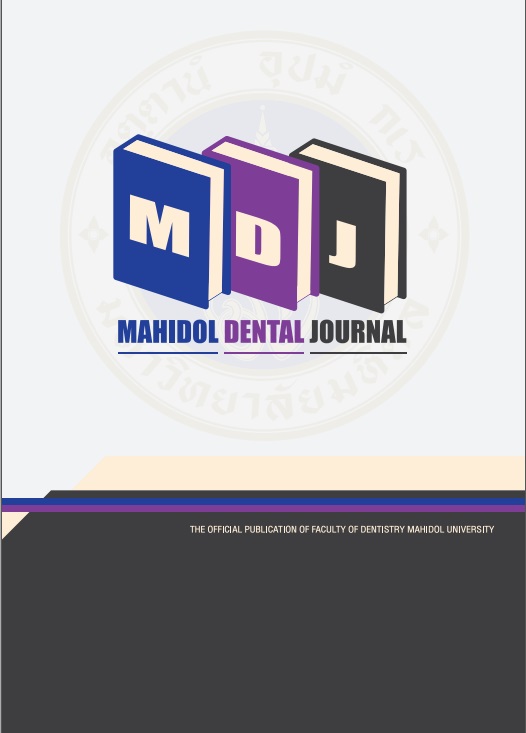Effect of adding zinc oxide and zirconium oxide on decreasing tooth discoloration from mineral trioxide aggregate in a regenerative endodontic model
Main Article Content
Abstract
Objectives: To investigate the effect of adding zirconium oxide (ZrO) or zinc oxide (ZnO) (5% by weight) on decreasing tooth discoloration from mineral trioxide aggregate in a regenerative endodontic tooth model over 28-day period.
Materials and methods: Thirty human mandibular premolars were prepared to achieve regenerative endodontic models and divided into three groups- (a) original MTA (MTA), (b) MTA+5% ZrO (MTA/ZrO), and (c) MTA+5% ZnO (MTA/ZnO). The powder of MTA was added with ZrO or ZnO in a blending machine until homogeneous. The powder was mixed with the liquid and then placed as a coronal barrier in 3-mm thick at the level of cemento-enamel junction. Each specimen was embedded in a block and placed on a customized platform to control tooth-color measuring area at cervical third on the buccal side. In a light-controlled box, tooth color in CIE L*a*b* values was measured using the spectrophotometer at day 1 (baseline) and day 28. The difference in tooth color was calculated into ΔE value. The specimens at day 28 were selected, horizontally sectioned and photographed to observe discoloration of MTA material and/or dentin.
Results: At day 28, ΔE of MTA (6.83±1.70) was significantly higher than MTA/ZrO (3.70±1.36) and MTA/ZnO (4.20±1.31) (p<0.01). In the sectioned specimens, severe discoloration was observed in MTA material and adjacent root dentin. MTA/ZrO and MTA/ZnO showed less discoloration of material and dentin.
Conclusion: Mixing 5% ZrO or ZnO into MTA containing bismuth oxide significantly decreased tooth discoloration in the regenerative endodontic model.
Article Details
References
Ha WN, Nicholson T, Kahler B, Walsh LJ. Mineral Trioxide Aggregate-A Review of Properties and Testing Methodologies. Materials (Basel) 2017: Nov 2; 10: 1261.
Tawil PZ, Duggan DJ, Galicia JC. Mineral trioxide aggregate (MTA): its history, composition, and clinical applications. Compend Contin Educ Dent 2015; 36: 247-52.
Parirokh M, Torabinejad M. Mineral trioxide aggregate: a comprehensive literature review--Part III: Clinical applications, drawbacks, and mechanism of action. J Endod 2010; 36: 400-13.
Torabinejad M, Parirokh M, Dummer PMH. Mineral trioxide aggregate and other bioactive endodontic cements: an updated overview - part II: other clinical applications and complications. Int Endod J 2018; 51: 284-317.
Hosoya N, Takigawa T, Horie T, Maeda H, Yamamoto Y, Momoi Y, et al. A review of the literature on the efficacy of mineral trioxide aggregate in conservative dentistry. Dent Mater J 2019; 38: 693-700.
Trongkij P, Sutimuntanakul S, Lapthanasupkul P, Chaimanakarn C, Wong RH, Banomyong D. Pulpal responses after direct pulp capping with two calcium-silicate cements in a rat model. Dent Mater J 2019; 38: 584-90.
Marciano MA, Duarte MA, Camilleri J. Dental discoloration caused by bismuth oxide in MTA in the presence of sodium hypochlorite. Clin Oral Investig 2015; 19: 2201-9.
Marciano MA, Camilleri J, Costa RM, Matsumoto MA, Guimaraes BM, Duarte MAH. Zinc Oxide Inhibits Dental Discoloration Caused by White Mineral Trioxide Aggregate Angelus. J Endod 2017; 43: 1001-7.
Camilleri J. Color stability of white mineral trioxide aggregate in contact with hypochlorite solution. J Endod 2014; 40: 436-40.
Marciano MA, Costa RM, Camilleri J, Mondelli RF, Guimarães BM, Duarte MA. Assessment of color stability of white mineral trioxide aggregate angelus and bismuth oxide in contact with tooth structure. J Endod 2014; 40: 1235-40.
Vallés M, Mercadé M, Duran-Sindreu F, Bourdelande JL, Roig M. Influence of light and oxygen on the color stability of five calcium silicate-based materials. J Endod 2013; 39: 525-8.
Adl A, Javanmardi S, Abbaszadegan A. Assessment of tooth discoloration induced by biodentine and white mineral trioxide aggregate in the presence of blood. J Conserv Dent 2019; 22: 164-8.
Felman D, Parashos P. Coronal tooth discoloration and white mineral trioxide aggregate. J Endod 2013; 39: 484-7.
Vibulcharoenkitja P, Banomyong D, Sutimuntanakul S. Radiopacity of Biodentine, Bio-MA, and calcium silicate-based cement added with different radiopacifiers. M Dent J 2019; 39: 199-205.
Suliman S, Sulaiman TA, Olafsson VG, Delgado AJ, Donovan TE, Heymann HO. Effect of time on tooth dehydration and rehydration. J Esthet Restor Dent 2019; 31: 118-23.
Burki Z, Watkins S, Wilson R, Fenlon M. A randomised controlled trial to investigate the effects of dehydration on tooth colour. J Dent 2013; 41: 250-7.
Johnston WM, Kao EC. Assessment of appearance match by visual observation and clinical colorimetry. J Dent Res 1989; 68: 819-22.
Cutajar A, Mallia B, Abela S, Camilleri J. Replacement of radiopacifier in mineral trioxide aggregate; characterization and determination of physical properties. Dent Mater 2011; 27: 879-91.
Li Q, Deacon AD, Coleman NJ. The impact of zirconium oxide nanoparticles on the hydration chemistry and biocompatibility of white Portland cement. Dent Mater J 2013; 32: 808-15.
Han L, Okiji T, Okawa S. Morphological and chemical analysis of different precipitates on mineral trioxide aggregate immersed in different fluids. Dent Mater J 2010; 29: 512-7.


